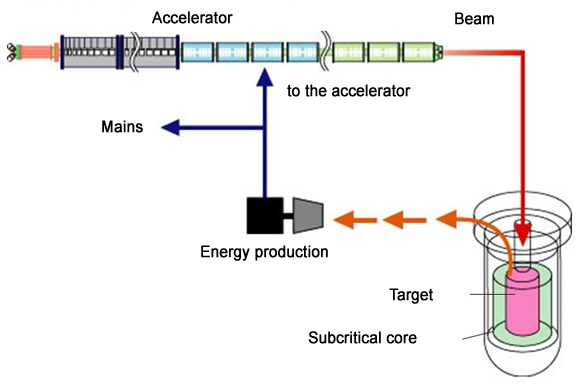Zholdybaev Timur Kadyrzhanovich,
Head of the Nuclear Physics Department, The Institute of Nuclear Physics ME RK
The peaceful use of nuclear energy is the integral part of the technological platform for existence of modern mankind and the important component of its sustainable development. Gamma-radiation, the fluxes of neutrons and charged particles are widely used as a tool in solving the tasks of automatic control of the production processes, modification of materials, reducing the amount of harmful industrial emissions, non-destructive testing of critical products, searching for minerals, diagnostics and therapy of various diseases, etc.
Nuclear energy occupies a special place in a number of applications of atomic energy. Currently, the world is facing the acute problem of energy production in the scale required for sustainable economic growth without disturbance of the ecological balance. At the same time, accumulation of the large amounts of carbon dioxide in the atmosphere as a result of energy generation from organic materials should be taken into account, leading to the climate change on the planet.
At present, the efforts of the nuclear scientists around the world are intended to solve the following main tasks for further development of the nuclear energy:
- Improving the safety of the nuclear power plants and increasing the service-life of the new type reactors;
- Expansion of the fuel base of the nuclear power industry;
- Reducing accumulation of radioactive waste and improving the technology for its disposal;
- Enhancing the economic competitiveness of the nuclear energy.
However, the large amount of the generated radioactive waste significantly reduces the capability of increasing the share of electricity generated by the nuclear power plants. In this situation, the world is searching for the alternative ways of nuclear power development, which would solve such problems as increasing the safety level, reducing the amount of spent nuclear fuel and eliminating the non-controlled proliferation of nuclear weapons.
The idea of using so-called hybrid systems appeared in the sixties, in which the process of nuclear fission in the sub-critical reactors is supported by additional neutrons and light charged particles obtained during the cleavage and fission of nuclei in the reactions with protons accelerated to the energies of 0.8-1 GeV. According to the physical scenario of ADS operation (Figure 1), high-energy protons, passing through the target assembly, generate a neutron flux, while 30-40 secondary particles are produced per 1 proton, which is quite enough for reliable control of the reactor operation mode.

Figure 1 – Schematic diagram of ADS operation
Such facilities are characterized by the following advantages over the currently operating thermal and fast neutron reactors:
- High safety associated with non-inertia of such installations. Their reactivity in case of no external source can be quite small, and the chain reaction will decay very quickly;
- Possibility of using Th-232 and U-238 as fuel, thereby achieving a significant expansion of the fuel base of the nuclear power industry;
- Low production of radioactive waste and transuranic elements, and at the same time, capability of long-lived radionuclides transmutation. The high neutron fluxes (in comparison with the traditional reactors) and the use of the Th-232/U-233 thorium cycle should lead, according to the experts’ opinion, to establishment of a balance between accumulation and burn-up of the long-lived radioactive isotopes in the next 100 years, if the hybrid power plants become as widespread as the traditional reactors.
- Reducing the costs of disposal and storage of radioactive waste, which will lead to increase in the commercial competitiveness of such facilities, not speaking about a decrease in the harmful anthropogenic impact on the environment.
- Hybrid nuclear facilities can play a significant role in destruction of the weapons-grade fissile materials, accumulated in the world until present moment, in the quantities that pose a threat to mankind nuclear security (proliferation of nuclear weapons, the risk of nuclear blackmail, possible leaks during storage, etc.).
Implementation of the above ideas has been hampered for the long time by the lack of the charged particle accelerators capable of meeting the requirements arising during creation of the hybrid facilities. This is a high current value (more than 100 mA) at high proton energies (0.8-1.0 GeV), stability of parameters, reliability, etc. Recently, the progress achieved in the area of accelerating technologies has already made it possible to address the issue of creating the accelerators suitable for use in the hybrid systems.
It should be noted that the range of nucleon composition and the energies of fissile nuclei excitation in the hybrid facilities is much wider than the corresponding ranges in the traditional reactors. Consequently, this will require new constant support, which in turn will require systematic information on the reactions of protons and light charged particles of low and medium energies with various nuclei, the characteristics of fission fragments in a wide range of nucleon composition and the excitation energies of fissile nuclei, the functions of radioactive isotopes excitation, etc.
At the moment, research in the area of hybrid reactors creation is being intensively performed in many countries of the world. International coordination is maintained by the International Atomic Energy Agency (IAEA) and the European Nuclear Agency (NEA). These works require the consolidated efforts of the specialists in the area of nuclear physics, solid state physics, kinetics of nuclear reactors, accelerator technology, atomic and radiation safety, chemistry and many other areas.
